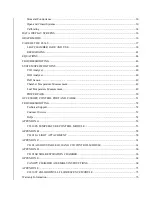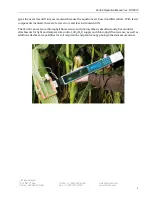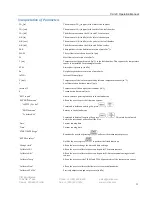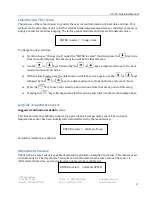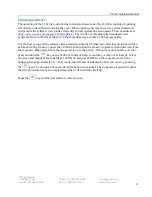
CI-340 Operation Manual
CID Bio-Science
1554 NE 3
rd
Ave
Camas, WA 98607, USA
Phone: +1 (360) 833-8835
Fax: +1 (360) 833-1914
sales@cid-inc.com
www.cid-inc.com
7
General Operating Instructions
This section will familiarize you with start-up procedures and guide you on how to move from one
function to another. Specific instructions for each separate function will be found under their individual
heading in the main body of the manual.
For greatest accuracy, the instrument should be turned on 30 minutes prior to any calibrations to allow
it to be fully warmed up. Measurements can be made about 3 minutes after the displayed CO
2
value
starts to drop from its maximum.
1.
The instrument needs to warm up awhile before it is used to measure. The warm up is
measured from the time the instrument is powered on (it does not matter if it is measuring or
not). A warm up of about 4 minutes would be the minimum time to get measurements and
about 20 minutes for more precise measurements.
2.
It is best to put the leaf into the chamber before you start the measurement so the leaf has time
to acclimate to the leaf chamber conditions and the instrument has time to react to the changes
the leaf causes. The "Working" display is a period that the instrument uses to stabilize
itself. The actual measurement starts when the display changes from "Working".
3.
Variations in the CO
2
readings or Pn readings can often be caused by changes in the air stream
going into the instrument. The CO
2
content of the stream must be very stable. Some
researchers use a long tube to get the intake away from human activity. Some use compressed
air (with a pressure regulator and a T in the hose). Some use a volume buffer (a 2 liter bottle or
larger with the hose from the instrument drawing air from inside that is vented to allow outside
air in) that will average out CO
2
changes over time. If the experiments are done near a road
with vehicles, it is difficult to get stable CO
2
readings. If you do not have a source of compressed
air, you may try putting several volume buffers in series (the instrument draws from the first
bottle that draws from the second which then draws from the third which is vented) The
instrument is sensitive enough to detect fires that are hundreds of meters away if they are
upwind.
4.
The flow rate can be reduced when the photosynthesis is minimal. Try 0.3 lpm for most
situations and 0.25 lpm if the readings are low.
Using the Keypad
The keypad for the CI-340 consists of 20 keys to enter commands and data. Figure 3-1 illustrates the
keypad.
Pressing a key makes a “beeping” sound. A key should be pressed individually each time a
command or letter is asked for. Refer to the
TROUBLESHOOTING
chapter if problems occur.
Summary of Contents for CI-340
Page 3: ......


